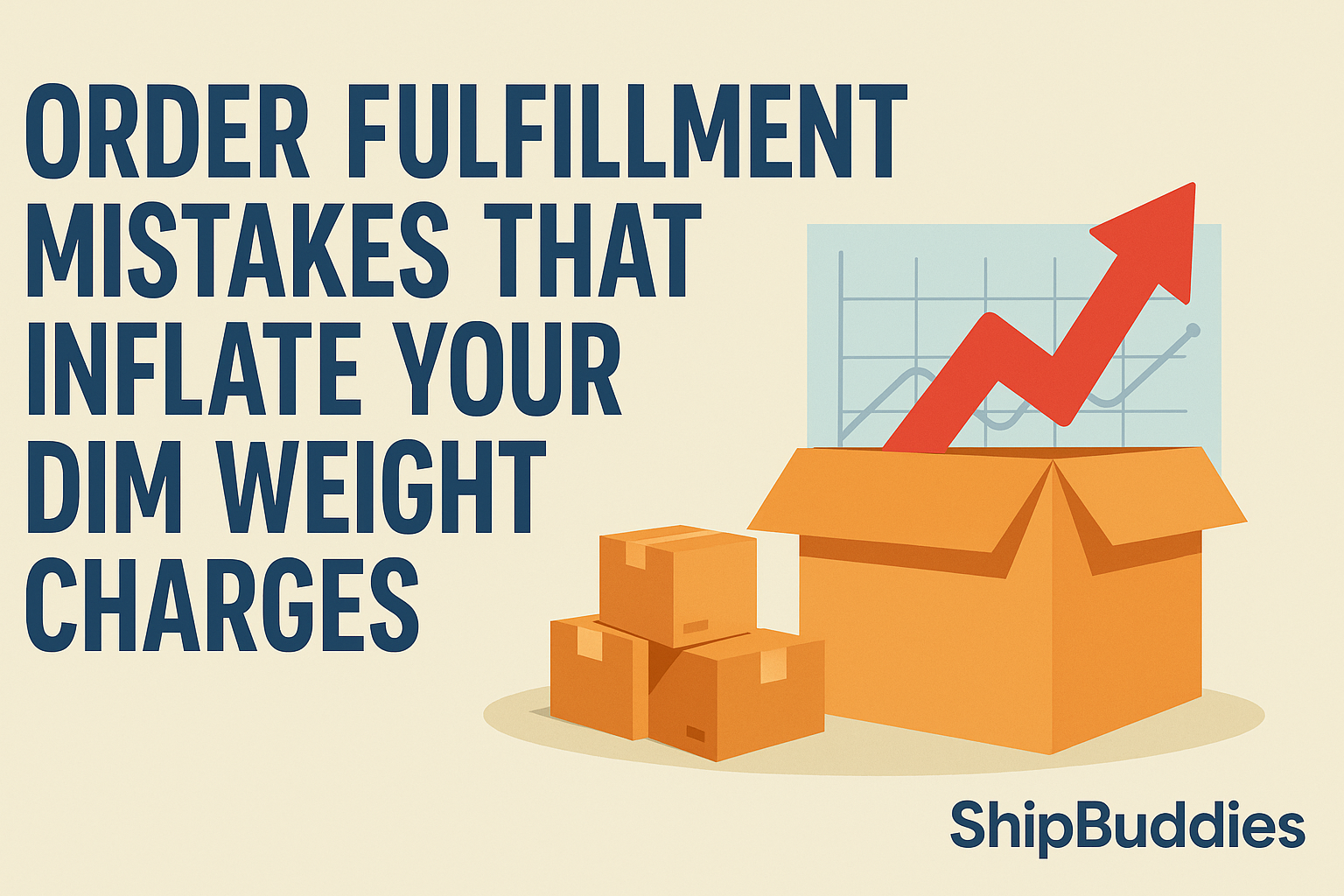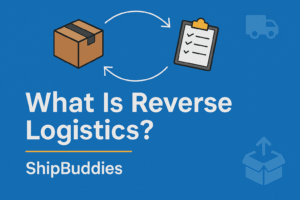When it comes to shipping costs, the details of your order fulfillment process can make or break your bottom line. For many ecommerce businesses, unexpected dimensional weight (DIM weight) charges can quietly eat into profits, often as a result of avoidable mistakes made during picking, packing, and shipping. Whether you’re sending small, lightweight items in oversized boxes or missing key steps in your workflow, even small errors can lead to inflated shipping fees that add up quickly.
Understanding how order fulfillment mistakes directly impact your DIM weight charges isn’t just about cutting costs. It’s about optimizing your entire shipping operation for efficiency, accuracy, and customer satisfaction. In this guide, we’ll break down exactly what dimensional weight is, why it matters, and the most common fulfillment errors that trigger extra fees. Plus, you’ll discover actionable steps and tools, trusted by leading brands and available through ShipBuddies, to help you audit, correct, and prevent these costly issues.
What Is Dimensional Weight (DIM Weight)?
Dimensional weight, often called “DIM weight,” is a pricing technique used by shipping carriers to account for both the size and weight of your packages. Instead of charging you solely by how much your shipment weighs on a scale, carriers also consider how much space it occupies in the truck or plane. This means that large, lightweight boxes can end up costing you more than small, dense packages, even if they weigh the same.
How Is DIM Weight Calculated?
The standard DIM weight formula used by most major carriers is:
(Length × Width × Height) ÷ DIM Divisor = Dimensional Weight
- All dimensions are measured in inches, and the divisor is a number set by the carrier (commonly 139 or 166).
- The result is rounded up to the next whole pound.
| Example | Length | Width | Height | Divisor | DIM Weight Calculation | Billed Weight (lbs) |
| Box 1 (Light, Large) | 20″ | 16″ | 12″ | 139 | (20×16×12) ÷ 139 = 27.6 | 28 |
| Actual Weight | — | — | — | — | 8 lbs | — |
In this example, you pay for 28 pounds, not the actual 8 pounds, because the box takes up so much space.
Why Does Dimensional Weight Matter?
Shipping carriers use DIM weight to optimize space and profitability. For ecommerce brands, misunderstanding DIM weight can lead to paying for unused space, especially if you use oversized boxes or unnecessary packing materials.
If your order fulfillment team isn’t measuring and packaging orders efficiently, DIM weight charges can quickly inflate your shipping bills, reduce margins, and surprise your customers at checkout.
How Carriers Calculate DIM Weight Charges
Every major shipping carrier, including FedEx, UPS, and USPS, has its own rules and formulas for calculating dimensional weight charges. Understanding these differences is essential if you want to control costs and avoid unnecessary surcharges on your shipments.
Carrier DIM Weight Formulas
Most carriers use the same basic DIM weight formula:
(Length × Width × Height) ÷ DIM Divisor = Dimensional Weight
However, the DIM divisor (the number you divide by) varies from carrier to carrier and may even change depending on the type of service you use. The lower the divisor, the higher your billed dimensional weight will be.
Carrier Comparison Table
| Carrier | Domestic DIM Divisor | International DIM Divisor | Applies to Packages Over: | Special Notes |
| FedEx | 139 | 139 | All packages | Applies to Ground and Express |
| UPS | 139 | 139 | All packages | Applies to Ground and Air |
| USPS | 166 | 166 | > 1 cubic foot (1,728 in³) | DIM only for larger boxes |
Always check current carrier rules. These numbers may change annually or with policy updates.
Why These Differences Matter
A box shipped with the same dimensions may result in different billed weights (and charges) depending on which carrier you use and the DIM divisor they apply. This makes it crucial for your fulfillment team to:
- Know which carriers’ rules apply to each order
- Select the most cost-effective carrier for each shipment
- Accurately measure and enter package dimensions in your shipping software
Key Takeaway
Choosing the wrong box or entering incorrect measurements can mean paying more than you need to, especially if you’re unaware of the subtle differences in carrier rules.
Why Order Fulfillment Processes Impact DIM Weight
The way your team picks, packs, and prepares orders for shipment plays a major role in how much you pay in DIM weight charges. Even if you know the DIM formulas and carrier rules, small workflow errors or outdated packing habits can quickly lead to bigger boxes, wasted space, and higher shipping bills.
How Workflow Influences Shipping Costs
- Box Selection:
Using boxes that are much larger than your products increases the dimensional weight, even if the items themselves are light. This is one of the most common fulfillment mistakes. - Packing Materials:
Overusing void fill (like bubble wrap, paper, or air pillows) not only adds cost but can force you into larger boxes than necessary, further inflating DIM charges. - Measurement Practices:
Manual measurement errors or skipping the dimension entry step can lead to incorrect data being sent to carriers, resulting in unexpected surcharges or billing adjustments. - Automation and Software:
Relying solely on manual processes increases the risk of inconsistent measurements and box choices. Modern fulfillment software and automation tools can help ensure that the right box is chosen every time and that dimensions are recorded accurately for each shipment.
Why It’s Not Just About the Box
Every step in your fulfillment workflow, from picking the product to choosing packing materials to closing up the box, affects the final package dimensions. Over time, small mistakes can add up to significant extra costs.
Key Takeaway
Optimizing your fulfillment process is essential for controlling DIM weight charges.
A streamlined, well-audited workflow ensures every order is packed efficiently, using the smallest possible box that safely protects your product – without paying more than you should in shipping fees.
The Most Common Fulfillment Mistakes That Inflate Your DIM Charges
Dimensional weight surcharges often sneak up on ecommerce businesses, not because of one big error, but a series of small, repeated mistakes in the fulfillment process. Here’s an expanded, practical look at the most common order fulfillment pitfalls that result in inflated DIM weight charges, and how to fix them.
Mistake 1: Using Oversized Boxes for Small or Lightweight Items
Why It Happens:
- Lack of box size variety in the warehouse.
- Staff “playing it safe” to avoid damage.
- Rush to ship quickly leads to defaulting to whatever box is handy.
Cost Impact Example:
Shipping a mug in a 12″x12″x12″ box instead of a snug 6″x6″x6″ box can mean being charged for up to 15 pounds DIM weight instead of the mug’s actual 2-pound scale weight. Multiplied across hundreds of orders, these small choices can add thousands to your monthly shipping spend.
Best Practices:
- Maintain a diverse box inventory: Regularly review SKUs and keep common box sizes in stock.
- Box selection training: Show your team the cost difference in real examples. Provide a simple “box choice” decision chart at packing stations.
- Implement right-size packaging technology: Some fulfillment centers use machines that cut boxes to the exact order size.
Mistake 2: Overusing Void Fill and Inefficient Packing
Why It Happens:
- Excessive focus on preventing damage (“better safe than sorry”)
- Lack of standardized packing guidelines
- Inexperienced staff not sure how much padding is “enough”
Cost Impact Example:
Filling a box with too much paper or bubble wrap can bump the package up to a larger box size, pushing the DIM weight into a more expensive rate bracket, even if the product is not fragile.
Best Practices:
- Standardize packing material use: Create guidelines for how much and what type of void fill to use for each SKU.
- Audit packing stations: Spot-check packed orders weekly for compliance and efficiency.
- Use inserts or custom foam: These protect products without adding unnecessary volume.
Mistake 3: Manual Dimension Entry Errors or Skipping Automation
Why It Happens:
- Rushed or inconsistent manual measurements.
- Staff rounding up measurements or using estimations.
- No integrated system connecting scales, dimensioners, and shipping software.
Cost Impact Example:
If an employee measures a box as 16” when it’s actually 15.5”, and rounds up all sides, that small overestimate can increase DIM weight and bump up charges. Worse, carriers may catch mismatches in declared vs. actual dimensions and apply penalty surcharges or re-rate your invoice.
Best Practices:
- Invest in automated dimensioners: Devices that scan and record box dimensions instantly.
- Integrate with shipping platforms: Auto-push measurements to your label printing system.
- Regular training and spot checks: Ensure staff know the financial impact of measurement errors.
Mistake 4: Failing to Validate Shipping Addresses Properly
Why It Happens:
- Relying on customer input without software validation.
- Manual address entry or cut-and-paste errors.
- Ignoring warnings from ecommerce platforms or carrier APIs.
Cost Impact Example:
An incorrect address might mean a package is sent to the wrong rate zone, or is delayed, resulting in re-labeling, extra handling, and possible DIM charge recalculation. Carriers can apply “correction” fees as high as $20 per package.
Best Practices:
- Enable automated address validation: Use built-in tools in your ecommerce platform or shipping software.
- Mandatory double-checks: Especially for high-value or international shipments.
- Train customer service staff: Address issues caught before fulfillment prevent expensive corrections later.
Mistake 5: Ignoring Carrier Chargebacks and Failing to Audit Shipping Invoices
Why It Happens:
- Lack of regular review of carrier bills and statements.
- No process for disputing overcharges or requesting refunds.
- Inattention to carrier audit notifications or “adjustment” surcharges.
Cost Impact Example:
A fulfillment center that doesn’t audit invoices could be paying thousands in extra DIM surcharges annually, either because of measurement discrepancies, incorrect entries, or simple carrier errors.
Best Practices:
- Schedule monthly shipping audits: Review random samples and high-volume shipments.
- Use audit software or a third-party refund service: These tools flag discrepancies for you.
- Track and appeal overcharges: File claims promptly to recover unnecessary costs.
Bonus Mistake: Not Keeping Up With Carrier Rule Changes
Carriers frequently update DIM divisor numbers, rules for minimum charges, and policies for certain shipping zones. Failing to adjust your workflows or update your shipping software can lead to sudden cost spikes and invoice surprises.
Action Step:
- Subscribe to carrier updates, and review your fulfillment process each time new rules are announced.
Real-World Tips From ShipBuddies Experts
- “We recommend creating a ‘DIM Impact’ dashboard. Track which SKUs most often trigger DIM surcharges, and adjust your box stock and packing methods accordingly.”
- “Automate whenever possible. DIM surcharges are often the result of human error and can be nearly eliminated with the right workflow and tech stack.”
Key Takeaway:
Each of these mistakes chips away at your bottom line. The good news: once you know what to look for, you can fix your fulfillment process to keep DIM charges under control, protect your margins, and deliver a better customer experience.
How Much Do These Mistakes Really Cost?
Dimensional weight mistakes aren’t just a theoretical problem. They have a measurable and often dramatic impact on your bottom line. Let’s break down the true cost of common fulfillment errors with real-world examples and easy-to-follow calculations.
Case Study 1: The Oversized Box Scenario
Situation:
A merchant ships a small kitchen gadget that weighs just 2 pounds in a box measuring 16″ x 12″ x 10″.
Carrier DIM divisor: 139
DIM Weight Calculation:
(16 × 12 × 10) ÷ 139 = 13.8 lbs (rounded up to 14 lbs)
Cost Impact:
- Actual weight billed: 2 lbs
- DIM weight billed: 14 lbs
- Extra charge: If the shipping rate is $0.60 per pound, that’s $7.20 for DIM vs. $1.20 for actual weight. That’s a 500% increase for a single package.
- Annual impact: Ship this item 1,000 times per year? That’s an extra $6,000 in unnecessary shipping costs.
Case Study 2: Manual Measurement Error
Situation:
A fulfillment worker estimates a box at 12″ x 12″ x 8″ when it’s actually 11.5″ x 11.5″ x 7.5″. Entering rounded-up dimensions results in higher DIM weight.
Correct DIM Calculation:
(11.5 × 11.5 × 7.5) ÷ 139 = 7.1 lbs (billed at 8 lbs)
Entered Dimensions:
(12 × 12 × 8) ÷ 139 = 8.3 lbs (billed at 9 lbs)
Cost Impact:
- Overcharge per shipment: 1 extra billed pound per package
- Annual impact: 2,000 shipments = 2,000 extra pounds billed; at $0.60/lb, that’s $1,200 lost to measurement error.
Case Study 3: Unchecked Carrier Chargebacks
Situation:
After a quarterly carrier audit, you receive a statement with $800 in DIM adjustments—fees for “incorrectly declared dimensions” across dozens of shipments.
Common Causes:
- Data entry mistakes
- Skipping dimension input
- Carrier rule changes not updated in shipping software
Impact:
- Unnecessary cost
- Potential lost disputes if you lack documentation or didn’t audit your invoices regularly
Before-and-After: Efficient Packing Saves Money
| Scenario | Box Size | DIM Weight | Actual Weight | Cost Per Ship | Shipments/Year | Annual Cost |
| Inefficient Packing | 18″ x 14″ x 10″ | 19 lbs | 7 lbs | $0.60/lb | 500 | $5,700 |
| Optimized Packing | 14″ x 10″ x 8″ | 8 lbs | 7 lbs | $0.60/lb | 500 | $2,400 |
Annual Savings:
By simply right-sizing packaging, you save $3,300 per year on this SKU alone.
Key Takeaway
Even small mistakes, when repeated across hundreds or thousands of shipments, can cost your business thousands of dollars annually.
By addressing box selection, measurement accuracy, and regular auditing, you unlock significant savings, and boost your profit margins.
How to Audit and Fix DIM Weight Mistakes in Your Workflow
Identifying and correcting DIM weight mistakes isn’t a one-time fix. It’s an ongoing process that requires attention to detail, smart use of technology, and a willingness to refine your fulfillment workflow. Here’s a practical, step-by-step guide to help you catch errors and keep dimensional surcharges under control.
Step 1: Conduct a Regular DIM Audit
- Review Shipping Invoices:
Look for unexpected surcharges or DIM adjustments from carriers. Flag any pattern of extra charges. - Sample Packages:
Randomly select recent shipments. Re-measure the boxes, re-calculate DIM weight, and compare billed vs. actual. - Spot-Check Packing Stations:
Observe your team’s packing habits. Are they reaching for the right box? Are they adding excess void fill?
Step 2: Analyze Box Size Usage
- Run a Box Utilization Report:
Use your warehouse management or shipping software to see which box sizes are used most, and whether they’re the best fit for your product mix. - Eliminate Redundant Sizes:
Remove boxes that are rarely used or almost always too large for the shipped items. - Add Missing Sizes:
If you see staff improvising or “making do,” invest in new box sizes or custom solutions.
Step 3: Upgrade to Automated Dimensioning and Measurement Tools
- Automated Scanners:
Install dimensioning devices that instantly and accurately measure every package—no manual entry needed. - Software Integration:
Ensure your measurement tools communicate directly with your shipping platform, preventing data errors or omissions.
Step 4: Implement Address Validation
- Activate Address Verification:
Use address validation at checkout and before label printing to prevent re-routing fees or rate zone mistakes. - Staff Training:
Train your team to resolve address errors immediately, not after the order is packed.
Step 5: Audit Carrier Rules and Update Software
- Stay Current:
Carriers frequently update DIM divisors, minimum charges, and surcharges. Review rules at least quarterly. - Update Systems:
Ensure all shipping, labeling, and calculation tools reflect the latest carrier policies.
Step 6: Empower Your Team
- Provide Training and SOPs:
Regularly train staff on the importance of accurate measurement, proper box selection, and minimizing void fill. - Encourage Feedback:
Ask packers and shippers for suggestions. Often, they’ll spot workflow improvements first.
Step 7: Leverage Tools and Partners (Like ShipBuddies)
- Use Calculators:
Try ShipBuddies’ DIM Weight Calculator to compare rates and spot problem shipments in advance. - Automated Auditing:
ShipBuddies clients can automate much of the audit process, catching costly errors before orders go out. - Schedule Routine Reviews:
Make audits a part of your monthly or quarterly operations review—not just a response to a problem.
Key Takeaway:
A proactive approach—combining routine audits, the right tools, and well-trained staff—can nearly eliminate DIM weight mistakes. The savings and efficiency gains add up quickly, making this one of the highest-ROI process improvements for any ecommerce operation.
ShipBuddies Solutions for DIM Optimization
At ShipBuddies, we understand that keeping DIM weight charges under control isn’t just about saving money. It’s about building a fulfillment process that’s smarter, leaner, and designed for growth. That’s why we’ve developed a suite of solutions to help ecommerce businesses like yours eliminate costly mistakes and maximize shipping efficiency.
1. Smart Box Selection and Inventory Management
- Dynamic Box Matching:
Our system recommends the most cost-effective box for every order, based on product dimensions and carrier rules. This eliminates guesswork and reduces the risk of oversized packaging. - Inventory Analysis:
We continually analyze your box usage data to suggest new sizes and retire inefficient options, ensuring you always have the right box on hand.
2. Fulfillment Process Auditing
- Routine Workflow Reviews:
Our fulfillment experts conduct regular audits of your packaging, measurement, and shipping data to catch inefficiencies or costly trends before they impact your bottom line. - Cost Recovery and Dispute Assistance:
If you’ve been overcharged for DIM weight, we help you identify discrepancies, file claims, and recover unnecessary fees from carriers.
3. Address Validation and Error Prevention
- Automated Address Checks:
Every order is validated for accuracy before shipping, reducing the risk of re-routing fees, address correction surcharges, and delayed deliveries.
4. ShipBuddies DIM Weight Calculator
- Self-Serve Tool:
Use our free DIM Weight Calculator to compare shipping options, understand true costs, and identify potential problem shipments before you pack.
5. Expert Training and Ongoing Support
- Customized Staff Training:
We provide training materials and hands-on support for your team, ensuring everyone understands best practices for packaging, measurement, and data entry. - Continuous Improvement:
ShipBuddies clients have access to ongoing process reviews and the latest fulfillment technology updates, keeping your business a step ahead.
Get Started
Ready to take control of your DIM weight charges?
- Try our free calculator
- Schedule a fulfillment audit
- Talk to a ShipBuddies expert about optimizing your workflow
Let ShipBuddies help you ship smarter, save more, and grow faster—without worrying about hidden DIM surcharges.
FAQs – DIM Weight & Fulfillment Mistakes
What is the DIM divisor, and why does it matter?
The DIM divisor is the number used by shipping carriers to calculate dimensional weight. It determines how much space your package takes up relative to its actual weight. A lower divisor means higher DIM weight charges for the same box size. Staying up-to-date with carrier-specific divisors is critical for accurate shipping cost calculations.
How can I pick the right box size for shipping?
Always choose the smallest box that safely fits your product with minimal extra space. Use a variety of box sizes, and consider right-size packaging solutions or automated box selection tools to match each order to the most cost-efficient option.
What tools can automate dimensional weight calculations?
Automated dimensioning devices instantly scan and record box dimensions. Integrate these with your shipping software to eliminate manual entry errors. Online DIM weight calculators (like the free one from ShipBuddies) are also valuable for planning and spot-checking shipments.
How do I audit my warehouse for DIM weight mistakes?
Start by reviewing shipping invoices for unexplained surcharges. Randomly sample packed boxes, measure their actual dimensions, and recalculate DIM weight. Analyze which box sizes are used most and least, and look for patterns in packing habits or measurement errors.
Are address errors linked to higher shipping charges?
Yes. Incorrect or incomplete addresses can cause packages to be routed to the wrong zone, triggering unexpected rate increases or adjustment fees. Some carriers also add address correction surcharges, which can significantly inflate shipping costs.
Can DIM weight charges be recovered if a mistake is found?
In many cases, yes. If you identify billing errors, such as incorrect measurements or misapplied surcharges, you can file claims with your carrier for refunds or adjustments. ShipBuddies assists clients in auditing invoices and managing claims for overcharges.
What are the best practices for preventing DIM weight mistakes?
- Maintain a wide variety of box sizes
- Standardize packing materials and methods
- Automate measurement and address validation
- Train staff regularly on packing and dimensioning best practices
- Use software that stays current with carrier rules
How often do carrier rules for DIM weight change?
Carrier rules, including DIM divisors and surcharge policies, may change annually, or even more frequently. It’s important to review your shipping processes and software quarterly and subscribe to carrier updates to stay compliant.
Does ShipBuddies offer solutions for reducing DIM weight errors?
Absolutely. ShipBuddies provides smart box selection, automated measurement, carrier rule compliance, fulfillment audits, and more—plus a free online DIM Weight Calculator and ongoing training for your team.
Have more questions?
Contact ShipBuddies for expert advice or to schedule a free fulfillment audit.







